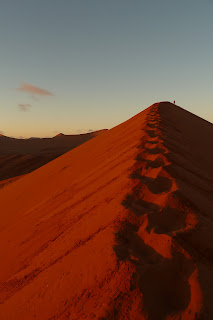 |
| The view from atop Table Mountain |
The next day was a day of goodbyes, as most of the group flew back to their homelands or off on other adventures. I was lucky that not only were 6 or 7 of the group spending a few extra days in Cape Town like me, but 2 of them were also staying at the same hostel as me. Despite the torrential rain of the morning, the afternoon turned out to be gloriously sunny and clear, giving me and a few of the others the opportunity to go up Table Mountain. We would have climbed up, but we realised that at 3pm, with a 2 hour hike up and no cable car back down, we should probably just take the cable car up!
The views from the top were fantastic, and we were so lucky because the next few days it was too windy and rainy to even see the top of the mountain- the locals call the clouds that cover the mountain the ‘tablecloth’. We could see for miles around, down to Cape Point and all across the city. And of course, what better way to finish a nice day trip out than with a cup of tea and a slice of cake in the tearoom at the top.
Later in the evening we met up with everyone that was staying in Cape Town for an Ethiopian meal. We all sat around these little tables, and when the food came it was presented on a huge pancake for us to share and we ate with our fingers.
 |
| A Stellenbosh winery |
I had pre-booked some day tours as I had no idea that anyone else would be staying in Cape Town with me, and so on the Saturday I went on a wine tour. We had a great tour guide called Ferne who took us to 4 different wineries in the Stellenboch region. The first was voted the most green in SA for its sustainable practices and use of renewable energies. The second was also on olive oil producer, so we got to taste a few of their varieties of oil. At the third we had lunch, which I imagine would be Michelin starred if the Michelin man knew about it! The last winery also did goats cheese tastings alongside their wines, which funnily enough were named ‘Goats do Roam’ after the famous Cote du Rhone wines of France.
By the end of the day, me and the two Irish lads (who were actually getting on a flight later that night, and were drunk before we even started the 9am tour!) were more than a little merry! Unfortunately due to the amount drunk, I then bought myself 3 bottles of wine which I then had 2 days to drink before leaving for Australia.
 |
| African penguins at Boulder Beach |
Sunday was an early start to go on a tour down the coast to Cape Point, the most south-westerly point of Africa. Our first stop of the day was Camps Bay where a few people took a boat trip to see some seals, but I opted to take a walk around the harbour and enjoy the sunshine. Next we headed down to Boulder Beach where a large colony of African penguins reside. These penguins didn’t actually reside on this beach until the mid-80’s when a naval base was established in nearby Simonstown and they restricted fishing activity in the area. The penguin colony has grown massively since then, and they are everywhere (even breaking into local back gardens to use the swimming pools!).
 |
| Attempting to not fall off with the cross winds on the peninsula! |
From Boulder Beach we headed on down to the Cape of Good Hope and Cape Point to explore the end of the Cape Peninsula. From Cape Point, we were all set up with bikes and let loose on the roads (I had actually forgotten I had booked a bicycle tour which was interesting!) with the challenge of getting back to the information centre where we had lunch. It was actually a lot of fun, especially with my roommate who was on the tour too having not ridden a bike for about 20 years! We even chose to do a bit extra as we were having such a laugh!
By the time Monday rolled around there were only 3 of us left, and the only big thing we had left to do was Robben Island, where Nelson Mandela was interred for most of his 27 years in prison. The island has been used as a prison of sorts for hundreds of years, right from when the Dutch and German invaders first landed, with a brief stint as an insane asylum and leper colony, and finally as a prison for political prisoners and black men during the apartheid era up until
 |
| View of Table Mountain from Robben Island |
I really enjoyed Cape Town, and felt very safe there- probably as a result of the FIFA World Cup being held there last year. There was a noticeable police presence, and even at weekends it didn’t look like there was too much trouble from weekend revellers! I would definiteley recommend Cape Town, but next time I would like to spend more time exploring the surrounding areas and countryside.















































